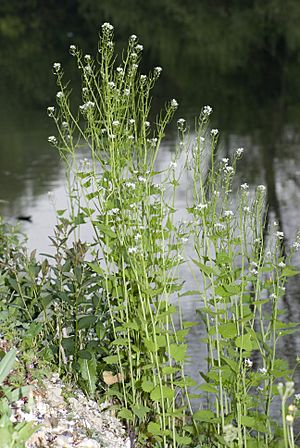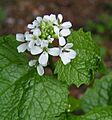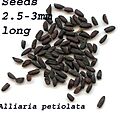Garlic mustard facts for kids
Quick facts for kids Garlic mustard |
|
|---|---|
 |
|
| Scientific classification | |
| Genus: |
Alliaria
|
| Species: |
petiolata
|
| Synonyms | |
|
|
Garlic mustard (scientific name: Alliaria petiolata) is a type of flowering plant that belongs to the mustard family. It is called a biennial plant because it lives for two years. In its first year, it grows leaves, and in its second year, it flowers and produces seeds.
This plant originally comes from Europe, parts of Asia, and North Africa. You can find it in places like the British Isles, Scandinavia, and even as far east as Pakistan and western China.
When you crush the leaves of garlic mustard, they smell like garlic. In its first year, the plant forms a bunch of round, slightly wrinkled leaves close to the ground. The next spring, it grows white, cross-shaped flowers in tight groups. After flowering, it makes long, thin fruits that release seeds in mid-summer. People often find this plant growing along the edges of hedges, which is why it's sometimes called jack-by-the-hedge. Other common names include hedge garlic and poor man's mustard. The name Alliaria comes from the word Allium, which refers to the garlic-like smell.
Contents
What Garlic Mustard Looks Like
Garlic mustard is an herbaceous plant, meaning it has soft stems, not woody ones like a tree. It grows from a deep, thin, whitish root that smells a bit like horseradish.
In its first year, the plant stays low to the ground, forming a group of green leaves called a rosette. These leaves stay green all winter. In the second spring, the plant grows taller, usually between 30 and 100 centimeters (about 1 to 3 feet) high. Its leaves are shaped like triangles or hearts, about 10 to 15 cm long and 5 to 9 cm wide. They have rough, jagged edges and grow on stalks called petioles.
Life Cycle and Reproduction
The small white flowers appear in spring and summer. Each flower has four white petals, arranged in a cross shape. After the flowers bloom, the plant produces long, thin, four-sided seed pods called siliques. These pods are about 4 to 5.5 cm long and start green, then turn light gray-brown. Inside, they hold two rows of tiny, shiny black seeds. When a silique opens, the seeds scatter, often traveling several meters from the parent plant. A single garlic mustard plant can make hundreds of seeds!
Garlic mustard flowers can either self-fertilize (pollinate themselves) or be cross-pollinated by different insects. The small white flowers have a slightly unpleasant smell that attracts insects like midges and hoverflies.
Insects and Other Animals
In Europe, many insects and fungi are known to interact with garlic mustard. Some important natural enemies include weevils, leaf beetles, butterflies, and moths. For example, the larvae (caterpillars) of the garden carpet moth feed on it. In June, the pale green caterpillar of the orange tip butterfly can be found eating the long green seed-pods.
How People Use Garlic Mustard
Garlic mustard is one of the oldest spices used in Europe. Scientists have found traces of it in ancient pottery from 4100–3750 BCE in Germany and Denmark, showing it was used a very long time ago.
In 17th-century Britain, people suggested using it to flavor salted fish. It could also be made into a sauce for roast lamb or salads. Early European settlers brought this herb to the New World (North America) to use as a garlic-like flavoring. They also used it for traditional medicine, believing it could act as a diuretic (helping the body get rid of extra water). Sometimes, it was even planted to help stop soil from washing away (erosion control).
Today, people still chop the young leaves to add flavor to salads and sauces, like pesto. Sometimes, the flowers and fruits are also used. The leaves taste like both garlic and mustard. In France, the seeds are sometimes used to season food. In the past, garlic mustard was used as a disinfectant or to treat wounds.
Is Garlic Mustard Toxic?
Young garlic mustard plants contain a small amount of a substance called cyanide. This amount can be harmful to many animals with backbones (vertebrates). However, when the plant is chopped up, this substance is usually eliminated.
Garlic Mustard in North America
Garlic mustard was brought to North America by European settlers in the 1800s. They used it for cooking and medicine. It was first recorded in Long Island in 1868 and has since spread across much of North America, especially the Northeast and Midwest, and southeastern Canada.
In North America, garlic mustard is considered an invasive species. This means it's a plant that is not native to the area and spreads quickly, often harming the local environment. It can take over the forest floor, reducing the number of different plants and animals (which is called biodiversity). Many native animals find it toxic or don't like to eat it. It's also harmful to the larvae (caterpillars) of some rare native butterfly species, like the Pieris oleracea and Pieris virginiensis. This is because garlic mustard produces chemicals that these native butterflies are not used to.
Scientists are trying to find ways to control garlic mustard in North America. They have looked at some of the insects that naturally control it in Europe, like certain types of weevils. The goal is to introduce these natural enemies to help keep garlic mustard from spreading too much. However, getting approval to release these insects is a long and careful process.
Images for kids
See also
 In Spanish: Hierba del ajo para niños
In Spanish: Hierba del ajo para niños



